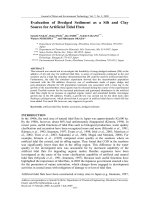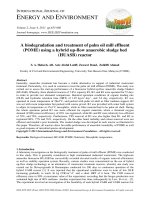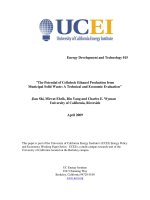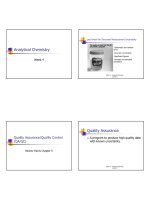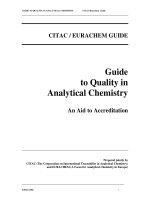Analytical chemistry a chemist and laboratory technicians toolkit 2015
Bạn đang xem bản rút gọn của tài liệu. Xem và tải ngay bản đầy đủ của tài liệu tại đây (42.67 MB, 683 trang )
ANALYTICAL CHEMISTRY
ANALYTICAL CHEMISTRY
A Chemist and Laboratory Technician’s Toolkit
BRYAN M. HAM
AIHUI MAHAM
Copyright © 2016 by John Wiley & Sons, Inc. All rights reserved
Published by John Wiley & Sons, Inc., Hoboken, New Jersey
Published simultaneously in Canada
No part of this publication may be reproduced, stored in a retrieval system, or transmitted in any form or by
any means, electronic, mechanical, photocopying, recording, scanning, or otherwise, except as permitted
under Section 107 or 108 of the 1976 United States Copyright Act, without either the prior written
permission of the Publisher, or authorization through payment of the appropriate per-copy fee to the
Copyright Clearance Center, Inc., 222 Rosewood Drive, Danvers, MA 01923, (978) 750-8400, fax (978)
750-4470, or on the web at www.copyright.com. Requests to the Publisher for permission should be
addressed to the Permissions Department, John Wiley & Sons, Inc., 111 River Street, Hoboken, NJ 07030,
(201) 748-6011, fax (201) 748-6008, or online at />Limit of Liability/Disclaimer of Warranty: While the publisher and author have used their best efforts
in preparing this book, they make no representations or warranties with respect to the accuracy or
completeness of the contents of this book and specifically disclaim any implied warranties of
merchantability or fitness for a particular purpose. No warranty may be created or extended by sales
representatives or written sales materials. The advice and strategies contained herein may not be suitable for
your situation. You should consult with a professional where appropriate. Neither the publisher nor author
shall be liable for any loss of profit or any other commercial damages, including but not limited to special,
incidental, consequential, or other damages.
For general information on our other products and services or for technical support, please contact
our Customer Care Department within the United States at (800) 762-2974, outside the United States
at (317) 572-3993 or fax (317) 572-4002.
Wiley also publishes its books in a variety of electronic formats. Some content that appears in print may
not be available in electronic formats. For more information about Wiley products, visit our web site
at www.wiley.com.
Library of Congress Cataloging-in-Publication Data:
Ham, Bryan M.
Analytical chemistry : a chemist and laboratory technician’s toolkit / Bryan M. Ham, Aihui Maham.
pages cm
Includes bibliographical references and index.
ISBN 978-1-118-71484-3 (cloth)
1. Chemistry, Analytic–Handbooks, manuals, etc. I. Maham, Aihui, 1974– II. Title.
QD78.H36 2016
543–dc23
2015018014
Cover image courtesy of Bryan M. Ham & Aihui MaHam
Set in 9.5/11.5pt Times by SPi Global, Pondicherry, India
Printed in the United States of America
10 9 8 7 6 5 4 3 2 1
1 2016
DEDICATION
This book is dedicated to the newest, most precious addition to our family: our first baby girl.
CONTENTS
Preface
xxiii
Author Biographies
Acknowledgments
1
Chemist and Technician in the Analytical Laboratory
1.1
1.2
1.3
1.4
1.5
2
2.2
xxvii
1
Introduction—The Analytical Chemist and Technician, 1
Today’s Laboratory Chemist and Technician, 1
1.2.1
Computers in the Laboratory, 1
1.2.2
Laboratory Information Management Systems (LIMS), 1
ChemTech—The Chemist and Technician Toolkit Companion, 1
1.3.1
Introduction to ChemTech, 1
1.3.1.1
Opening ChemTech, 2
1.3.1.2
Interactive Periodic Table, 2
Chapter Layout, 2
1.4.1
Glassware, Chemicals, and Safety, 2
1.4.2
Basic Math and Statistics, 2
1.4.3
Graphing and Plotting, 4
1.4.4
Making Laboratory Solutions, 4
1.4.5
Titrimetric Analysis, 4
1.4.6
Electrochemistry, 5
1.4.7
Laboratory Information Management System (or Software) LIMS, 5
1.4.8
Instrumental Analyses—Spectroscopy, 5
1.4.9
Instrumental Analyses—Chromatography, 5
1.4.10 Instrumental Analyses—Mass Spectrometry, 5
1.4.10.1 Mass Analyzers, 5
1.4.10.2 Mass Ionization, 5
1.4.11 Small Molecule and Macromolecule Analysis, 5
Users of ChemTech, 6
Introduction to the Analytical Laboratory
2.1
xxv
Introduction to the Laboratory, 7
2.1.1
The Scientific Method, 7
Laboratory Glassware, 7
2.2.1
Volumetric Flasks, 7
7
viii
CONTENTS
2.2.2
2.2.3
2.2.4
2.3
3
Laboratory Safety
3.1
3.2
3.3
3.4
3.5
3.6
3.7
3.8
3.9
3.10
3.11
3.12
3.13
3.14
3.15
3.16
4
Beakers and Erlenmeyer Flasks, 7
Graduated Cylinders, 8
Pipettes, 8
2.2.4.1
Steps for Using Pipette Bulb (a), 8
2.2.4.2
Steps for Using Pipette Bulb (b and c), 10
2.2.4.3
Autopipettes, 11
2.2.5
Evaporating Dishes, 11
2.2.6
Flames and Furnaces in the Laboratory, 11
2.2.6.1
Bunsen Burners, 11
2.2.6.2
Crucibles, 11
2.2.6.3
Ashing Samples, 11
2.2.6.4
Muffle Furnaces, 14
2.2.7
Laboratory Fume Hoods, 14
2.2.8
Drying Ovens, 15
2.2.9
Balances, 15
2.2.10 Refrigerators and Freezers, 16
2.2.11 Test Tubes, 16
2.2.12 Soxhlet Extractions, 16
2.2.13 Vacuum Pumps, 18
Conclusion, 18
Introduction, 19
Proper Personal Protection and Appropriate Attire, 19
3.2.1
Proper Eye Protection, 19
3.2.2
Proper Laboratory Coats, 20
Proper Shoes and Pants, 20
Laboratory Gloves, 20
3.4.1
Natural Rubber (Latex), 21
3.4.2
Nitrile, 22
3.4.3
Neoprene, 22
3.4.4
Butyl, 22
3.4.5
Polyvinyl Chloride (PVC), 22
3.4.6
Polyvinyl Alcohol (PVA), 22
3.4.7
Viton, 22
3.4.8
Silver Shield/4H, 22
General Rules to Use Gloves, 22
Material Safety Data Sheet (MSDS), 22
Emergency Eye Wash and Face Wash Stations, 23
Emergency Safety Showers, 24
Fire Extinguishers, 24
3.9.1
Types of Fires, 24
Clothing Fire in the Laboratory, 25
Spill Cleanup Kits, 25
Chemicals and Solvents, 27
First Aid Kits, 27
Gasses and Cylinders, 29
Sharps Containers and Broken Glass Boxes, 29
Occupational Safety and Health Administration (OSHA), 29
Basic Mathematics in the Laboratory
4.1
4.2
19
Introduction to Basic Math, 83
Units and Metric System, 83
4.2.1
Introduction to the Metric System, 83
4.2.2
Units of the Metric System, 83
4.2.3
Converting the SI Units, 84
83
CONTENTS
4.3
4.4
4.5
4.6
4.7
5
Significant Figures, 84
4.3.1
Significant Figure Rules, 84
Scientific Calculators, 86
4.4.1
Example Calculator, 86
4.4.2
Window’s Calculator, 86
4.4.2.1
Windows’ Scientific versus Standard Calculator, 86
ChemTech Conversion Tool, 89
4.5.1
Using the Conversion Tool, 89
4.5.2
Closing the Conversion Tool, 89
Chapter Key Concepts, 89
Chapter Problems, 92
Analytical Data Treatment (Statistics)
5.1
5.2
5.3
5.4
5.5
5.6
5.7
5.8
Errors in the Laboratory, 93
5.1.1
Systematic Errors, 93
5.1.2
Random Errors, 93
Expressing Absolute and Relative Errors, 94
Precision, 94
5.3.1
Precision versus Accuracy, 94
The Normal Distribution Curve, 94
5.4.1
Central Tendency of Data, 95
5.4.1.1
The Arithmetic Mean, 95
5.4.1.2
The Median, 95
5.4.1.3
The Mode, 95
5.4.1.4
Sticking with the Mean, 95
Precision of Experimental Data, 96
5.5.1
The Range, 96
5.5.2
The Average Deviation, 96
5.5.3
The Standard Deviation, 97
5.5.3.1
Root Mean Square, 97
5.5.3.2
Sample Standard Deviation, 97
5.5.3.3
Comparison of the Three Methods, 97
5.5.3.4
Using the Scientific Calculator, 97
5.5.3.5
Coefficient of Variation, 97
Normal Distribution Curve of a Sample, 97
ChemTech Statistical Calculations, 98
5.7.1
Introduction to ChemTech Statistics, 98
5.7.2
ChemTech Chapter 5, 98
5.7.2.1
Entering Data, 100
5.7.2.2
Calculating the Statistics, 100
5.7.2.3
The Results Output, 100
5.7.2.4
Results not Expected, 100
5.7.2.5
Using ChemTech for Large Value Set, 101
5.7.2.6
The Results Page, 101
5.7.2.7
Resetting the Page, 101
Student’s Distribution t Test for Confidence Limits, 101
5.8.1
Accuracy, 101
5.8.2
The Student’s t Test, 102
5.8.3
Calculating the Student’s t Value, 102
5.8.4
Probability Level, 103
5.8.5
Sulfate Concentration Confidence Limits, 103
5.8.6
Sulfate t Distribution Curve, 103
5.8.7
Determining Types of Error, 103
5.8.7.1
Glucose Content, 104
5.8.8
Determining Error in Methodology, 104
5.8.8.1
Magnesium Primary Standard, 104
93
ix
x
CONTENTS
5.9
5.10
5.11
5.12
6
Plotting and Graphing
6.1
6.2
6.3
6.4
6.5
6.6
6.7
6.8
6.9
6.10
6.11
6.12
7
Tests of Significance, 104
5.9.1
Difference in Means, 104
5.9.2
Null Hypothesis, 105
Treatment of Data Outliers, 105
5.10.1 The Q Test, 105
5.10.2 The Tn Test, 106
Chapter Key Concepts, 106
Chapter Problems, 107
109
Introduction to Graphing, 109
6.1.1
The Invention of the Graph, 109
6.1.2
Importance of Graphing, 109
Graph Construction, 109
6.2.1
Axis and Quadrants, 110
Rectangular Cartesian Coordinate System, 110
Curve Fitting, 110
Redrawn Graph Example, 110
Graphs of Equations, 111
6.6.1
Introduction, 111
6.6.2
Copper Sulfate Data, 111
6.6.3
Plotting the Data, 111
6.6.4
Best Fit Line, 111
6.6.5
Point-Slope Equation of a Line, 112
6.6.6
Finding the Slope (m), 112
6.6.7
Finding the y-Intercept (b), 112
6.6.8
Solving for x, 113
6.6.9
Estimating the Slope and Intercept, 113
6.6.10 Deriving the Equation from the Slope and Intercept, 113
Least-Squares Method, 114
6.7.1
Plotting Data with Scatter, 114
6.7.2
Linear Regression, 114
6.7.3
Curve Fitting the Data, 114
Computer-Generated Curves, 115
6.8.1
Using ChemTech to Plot Data, 115
6.8.2
Entering the Data, 115
6.8.3
Plotting the Data, 116
6.8.4
Linear Regression of the Data, 116
6.8.5
Adding the Best Fit Line, 118
6.8.6
Entering a Large Set of Data, 118
Calculating Concentrations, 119
Nonlinear Curve Fitting, 119
Chapter Key Concepts, 123
Chapter Problems, 124
Using Microsoft Excel® in the Laboratory
7.1
7.2
7.3
7.4
®
Introduction to Excel , 125
Opening Excel® in ChemTech, 125
The Excel® Spreadsheet, 125
7.3.1
Spreadsheet Menus and Quick Access Toolbars, 127
Graphing in Excel®, 127
7.4.1
Making Column Headings, 127
7.4.2
Entering Data into Columns, 128
7.4.3
Saving the Spreadsheet, 129
7.4.4
Constructing the Graph, 129
7.4.5
The Chart Wizard, 130
125
CONTENTS
7.5
7.6
7.7
7.8
8
7.4.6
The Chart Source Data, 130
7.4.7
Chart Options, 131
Charts in Excel® 2010, 132
Complex Charting in Excel® 97-2003, 132
7.6.1
Calcium Atomic Absorption (AAS) Data, 132
7.6.2
Entering Ca Data into Spreadsheet, 135
7.6.3
Average and Standard Deviation, 135
7.6.4
Constructing the Calibration Curve, 135
7.6.5
Entering the Chart Options, 136
7.6.6
Error Bars, 137
7.6.7
Trendline, 138
Complex Charting in Excel® 2010, 139
7.7.1
Entering the Data, 139
7.7.2
Using the Formula Search Function, 139
7.7.3
Inserting the Chart, 140
7.7.4
Formatting the Chart, 140
Statistical Analysis Using Excel®, 141
7.8.1
Open and Save Excel® StatExp.xls, 141
7.8.2
Sulfate Data, 141
7.8.3
Excel® Confidence Function, 142
7.8.4
Excel® Student’s t Test, 142
7.8.4.1
Spreadsheet Calculation I, 142
7.8.4.2
Spreadsheet Calculation II, 143
7.8.5
Excel® Tools Data Analysis, 143
7.8.5.1
Analysis ToolPak, 143
7.8.5.2
ToolPak Functions, 143
7.8.5.3
Data Analysis t-Test: Two-Sample Assuming Unequal
Variances, 144
7.8.5.4
Analysis ToolPak F-test, 145
7.8.5.5
Analysis ToolPak Statistical Summary, 145
Making Laboratory Solutions
8.1
8.2
8.3
8.4
8.5
8.6
8.7
8.8
8.9
Introduction, 147
Laboratory Reagent Fundamentals, 147
The Periodic Table, 147
8.3.1
Periodic Table Descriptive Windows, 148
Calculating Formula Weights, 148
Calculating the Mole, 148
Molecular Weight Calculator, 148
Expressing Concentration, 148
8.7.1
Formal (F) Solutions, 149
8.7.1.1
Formal (F) Solution Example, 149
8.7.2
Molal (m) Solutions, 149
8.7.2.1
Molal (m) Solution—Simple Example, 149
8.7.2.2
Molal (m) Solution—Complex Example, 149
8.7.3
Molar (M) Solutions, 150
8.7.3.1
Molar (M) Solution Example, 150
8.7.3.2
Molar (M) Solution of K2CO3, 151
8.7.4
Normal (N) Solutions, 151
8.7.4.1
Normal (N) Solution Calculation Example, 152
The Parts per (PP) Notation, 153
Computer-Based Solution Calculations, 153
8.9.1
Computer-Based Concentration Calculation—Molarity I, 154
8.9.2
Computer-Based Concentration Calculation—Molarity II, 154
8.9.3
Computer-Based Concentration Calculation—Normality I, 155
8.9.4
Computer-Based Concentration Calculation—Normality II, 156
147
xi
xii
CONTENTS
8.10
8.11
8.12
9
Reactions in Solution, 157
Chapter Key Concepts, 157
Chapter Problems, 158
Acid–Base Theory and Buffer Solutions
9.1
9.2
9.3
9.4
9.5
9.6
9.7
9.8
9.9
9.10
9.11
9.12
9.13
9.14
9.15
9.16
9.17
Introduction, 159
Acids and Bases in Everyday Life, 159
The Litmus Test, 159
Early Acid–Base Descriptions, 160
Brǿnsted–Lowry Definition, 160
The Equilibrium Constant, 161
The Acid Ionization Constant, 161
Calculating the Hydrogen Ion Concentration, 162
The Base Ionization Constant, 163
9.9.1
OH− Ion Concentration Example, 163
9.9.2
Percent Ionization Example, 164
Ion Product for Water, 164
The Solubility Product Constant (Ksp), 164
9.11.1 Solubility of Silver(I) Thiocyanate, 164
9.11.2 Solubility of Lithium Carbonate, 166
The pH of a Solution, 166
Measuring the pH, 167
9.13.1 The Glass Electrode, 167
Buffered Solutions—Description and Preparing, 168
9.14.1 Le Chatelier’s Principle, 169
9.14.2 Titration Curve of a Buffer, 169
9.14.3 Natural Buffer Solutions, 169
9.14.4 Calculating Buffer pH, 170
9.14.5 Buffer pH Calculation I, 170
ChemTech Buffer Solution Calculator, 170
Chapter Key Concepts, 171
Chapter Problems, 172
10 Titration—A Volumetric Method of Analysis
10.1
10.2
10.3
10.4
10.5
10.6
10.7
10.8
10.9
10.10
10.11
10.12
10.13
10.14
159
Introduction, 175
Reacting Ratios, 175
The Equivalence Point, 176
Useful Relationships for Calculations, 176
Deriving the Titration Equation, 176
10.5.1 Titration Calculation Example, 176
Titrations in ChemTech, 177
10.6.1 Acid/Base Titrations Using Molar Solutions, 177
10.6.2 Titration Calculation Example, 177
Acid/Base Titration Endpoint (Equivalence Point), 178
Acid/Base Titration Midpoint, 179
Acid/Base Titration Indicators, 180
10.9.1 The Ideal Indicator, 180
Titrations Using Normal Solutions, 181
10.10.1 Normal Solution Titration Example, 181
Polyprotic Acid Titration, 181
ChemTech Calculation of Normal Titrations, 182
Performing a Titration, 183
10.13.1 Titration Glassware, 183
10.13.2 Titration Steps, 183
Primary Standards, 184
175
CONTENTS
10.15 Standardization of Sodium Hydroxide, 185
10.15.1 NaOH Titrant Standardization Example, 185
10.16 Conductometric Titrations (Nonaqueous Solutions), 186
10.17 Precipitation Titration (Mohr Method for Halides), 188
10.17.1 Basic Steps in Titration, 188
10.17.2 Important Considerations, 189
10.18 Complex Formation with Back Titration
(Volhard Method for Anions), 189
10.18.1 Iron(III) as Indicator, 189
10.18.2 Chloride Titration, 189
10.18.3 The General Calculation, 189
10.18.4 Chloride Titration, 190
10.18.4.1 Volhard Chloride
Analysis Example, 190
10.18.4.2 The Titration Steps, 190
10.19 Complex Formation Titration with EDTA for Cations, 190
10.19.1 EDTA–Metal Ion Complex Formation, 191
10.19.2 The Stability Constant, 191
10.19.3 Metal Ions Titrated, 191
10.19.4 Influence of pH, 191
10.19.5 Buffer and Hydroxide Complexation, 192
10.19.6 Visual Indicators, 193
10.20 Chapter Key Concepts, 194
10.21 Chapter Problems, 195
11 Oxidation–Reduction (Redox) Reactions
11.1
11.2
11.3
11.4
11.5
Introduction, 197
Oxidation and Reduction, 197
The Volt, 198
The Electrochemical Cell, 198
Redox Reaction Conventions, 198
11.5.1 Electrode Potential Tables, 198
11.5.2 The Standard Hydrogen Electrode (SHE), 199
11.5.3 The SHE Half-Reaction, 199
11.5.4 Writing the Standard Electrode Potentials, 199
11.5.5 Drawing a Galvanic Cell, 199
11.5.6 Calculating the Cell Potential, 200
11.5.6.1 Iron and Zinc Cell, 200
11.5.6.2 Nickel and Silver Cell, 200
11.6 The Nernst Equation, 200
11.6.1 Nernst Equation Example I, 201
11.6.2 Nernst Equation Example II, 201
11.6.3 Nernst Equation Example III, 201
11.7 Determining Redox Titration Endpoints, 202
11.8 Potentiometric Titrations, 202
11.8.1 Detailed Potentiometer, 202
11.8.2 Half-Reactions, 202
11.8.3 The Nernst Equation, 203
11.8.4 Assumed Reaction Completion, 203
11.8.5 Calculated Potentials of Ce4+, 204
11.9 Visual Indicators Used in Redox Titrations, 204
11.10 Pretitration Oxidation–Reduction, 205
11.10.1 Reducing Agents, 205
11.10.2 Oxidizing Agents, 205
11.11 Ion-Selective Electrodes, 206
197
xiii
xiv
CONTENTS
11.12 Chapter Key Concepts, 206
11.13 Chapter Problems, 207
12 Laboratory Information Management System (LIMS)
12.1
12.2
12.3
12.4
12.5
12.6
12.7
12.8
12.9
Introduction, 209
LIMS Main Menu, 209
Logging in Samples, 209
Entering Test Results, 209
Add or Delete Tests, 211
Calculations and Curves, 212
Search Wizards, 214
12.7.1 Searching Archived Samples, 214
12.7.2 General Search, 214
12.7.3 Viewing Current Open Samples, 216
Approving Samples, 218
Printing Sample Reports, 220
13 Ultraviolet and Visible (UV/Vis) Spectroscopy
13.1
13.2
13.3
13.4
13.5
13.6
13.7
14.3
14.4
14.5
14.6
14.7
14.8
221
Introduction to Spectroscopy in the Analytical Laboratory, 221
The Electromagnetic Spectrum, 221
Ultraviolet/Visible (UV/Vis) Spectroscopy, 221
13.3.1 Wave and Particle Theory of Light, 222
13.3.2 Light Absorption Transitions, 223
13.3.3 The Color Wheel, 224
13.3.4 Pigments, 224
13.3.5 Inorganic Elemental Analysis, 224
13.3.6 The Azo Dyes, 225
13.3.7 UV-Visible Absorption Spectra, 228
13.3.8 Beer’s Law, 228
UV/Visible Spectrophotometers, 230
Special Topic (Example)—Spectrophotometric Study of Dye Compounds, 234
13.5.1 Introduction, 234
13.5.2 Experimental Setup for Special Topic Discussion, 235
13.5.3 UV/Vis Study of the Compounds and Complexes, 235
Chapter Key Concepts, 236
Chapter Problems, 237
14 Fluorescence Optical Emission Spectroscopy
14.1
14.2
209
Introduction to Fluorescence, 239
Fluorescence and Phosphorescence Theory, 240
14.2.1 Radiant Energy Absorption, 240
14.2.2 Fluorescence Principle—Jablonski Diagram, 240
14.2.3 Excitation and Electron Spin States, 240
14.2.3.1 Quantum Numbers, 241
14.2.3.2 Electron Spin States, 241
Phosphorescence, 241
Excitation and Emission Spectra, 242
Rate Constants, 243
14.5.1 Emission Times, 243
14.5.2 Relative Rate Constants (k), 243
Quantum Yield Rate Constants, 243
Decay Lifetimes, 244
Factors Affecting Fluorescence, 244
14.8.1 Excitation Wavelength (Instrumental), 244
14.8.2 Light Source (Instrumental), 244
14.8.3 Filters, Optics, and Detectors (Instrumental), 245
239
CONTENTS
14.8.4
14.8.5
14.9
14.10
14.11
14.12
14.13
14.14
Cuvettes and Cells (Instrumental), 245
Structure (Sample), 246
14.8.5.1 Fluorescein and Beta-(β)-Carotene, 246
14.8.5.2 Diatomic Oxygen Molecular Orbital Diagram, 246
14.8.5.3 Examples of Nonfluorescent and Fluorescent Compounds, 247
14.8.5.4 Other Structural Influences, 247
14.8.5.5 Scattering (Sample), 248
Quantitative Analysis and Beer–Lambert Law, 248
Quenching of Fluorescence, 249
Fluorometric Instrumentation, 249
14.11.1 Spectrofluorometer, 249
14.11.1.1 Light Source, 250
14.11.1.2 Monochromators, 250
14.11.1.3 Photomultiplier tube (PMT), 251
14.11.2 Multidetection Microplate Reader, 252
14.11.3 Digital Fluorescence Microscopy, 252
14.11.3.1 Light Source, 252
14.11.3.2 Filter Cube, 253
14.11.3.3 Objectives and Grating, 253
14.11.3.4 Charged-Coupled Device (CCD), 254
Special Topic—Flourescence Study of Dye-A007 Complexes, 255
Chapter Key Concepts, 257
Chapter Problems, 258
15 Fourier Transform Infrared (FTIR) Spectroscopy
15.1
15.2
15.3
15.4
15.5
15.6
15.7
15.8
15.9
Introduction, 261
Basic IR Instrument Design, 261
The Infrared Spectrum and Molecular Assignment, 263
FTIR Table Band Assignments, 264
FTIR Spectrum Example I, 270
FTIR Spectrum Example II, 270
FTIR Inorganic Compound Analysis, 271
Chapter Key Concepts, 271
Chapter Problems, 273
16 Nuclear Magnetic Resonance (NMR) Spectroscopy
16.1
16.2
16.3
16.4
16.5
16.6
16.7
16.8
261
Introduction, 277
Frequency and Magnetic Field Strength, 277
Continuous-Wave NMR, 278
The NMR Sample Probe, 280
Pulsed Field Fourier Transform NMR, 280
Proton NMR Spectra Environmental Effects, 280
16.6.1 Chemical Shift, 281
16.6.2 Spin–Spin Splitting (Coupling), 281
16.6.3 Interpretation of NMR Spectra, 283
16.6.3.1 2-Amino-3-Methyl-Pentanoic Acid, 283
16.6.3.2 Unknown I, 283
Carbon-13 NMR, 283
16.7.1 Introduction, 283
16.7.2 Carbon-13 Chemical Shift, 284
16.7.3 Carbon-13 Splitting, 286
16.7.4 Finding the Number of Carbons, 286
16.7.5 Carbon-13 NMR Examples, 286
Special Topic—NMR Characterization of Cholesteryl Phosphate, 287
16.8.1 Synthesis of Cholesteryl Phosphate, 288
16.8.2 Single-Stage and High-Resolution Mass Spectrometry, 288
16.8.3 Proton Nuclear Magnetic Resonance (1H-NMR), 289
277
xv
xvi
CONTENTS
16.8.4 Theoretical NMR Spectroscopy, 289
16.8.5 Structure Elucidation, 289
16.9 Chapter Key Concepts, 292
16.10 Chapter Problems, 293
References, 294
17 Atomic Absorption Spectroscopy (AAS)
17.1
17.2
17.3
17.4
17.5
17.6
17.7
17.8
17.9
17.10
Introduction, 295
Atomic Absorption and Emission Process, 295
Atomic Absorption and Emission Source, 296
Source Gases and Flames, 296
Block Diagram of AAS Instrumentation, 296
The Light Source, 297
Interferences in AAS, 299
Electrothermal Atomization—Graphite Furnace, 299
Instrumentation, 300
Flame Atomic Absorption Analytical Methods, 301
18 Atomic Emission Spectroscopy
18.1
18.2
18.3
18.4
18.5
18.6
18.7
19.3
20.4
20.5
325
Introduction, 325
Low-Resolution ICP-MS, 325
19.2.1 The PerkinElmer NexION® 350 ICP-MS, 325
19.2.2 Interface and Quadrupole Ion Deflector (QID), 325
19.2.3 The Collision/Reaction Cell, 325
19.2.4 Quadrupole Mass Filter, 328
High-Resolution ICP-MS, 328
20 X-ray Fluorescence (XRF) and X-ray Diffraction (XRD)
20.1
20.2
20.3
303
Introduction, 303
Elements in Periodic Table, 303
The Plasma Torch, 303
Sample Types, 304
Sample Introduction, 304
ICP-OES Instrumentation, 305
18.6.1 Radially Viewed System, 306
18.6.2 Axially Viewed System, 308
18.6.3 Ergonomic Sample Introduction System, 309
18.6.4 Innovative Optical Design, 310
18.6.5 Advanced CID Camera Technology, 310
ICP-OES Environmental Application Example, 310
19 Atomic Mass Spectrometry
19.1
19.2
295
X-Ray Fluorescence Introduction, 333
X-Ray Fluorescence Theory, 333
Energy-Dispersive X-Ray Fluorescence (EDXRF), 334
20.3.1 EDXRF Instrumentation, 334
20.3.1.1 Basic Components, 334
20.3.1.2 X-Ray Sources, 334
20.3.1.3 Detectors, 335
20.3.2 Commercial Instrumentation, 337
Wavelength Dispersive X-Ray Fluorescence (WDXRF), 337
20.4.1 Introduction, 337
20.4.2 WDXRF Instrumentation, 338
20.4.2.1 Simultaneous WDXRF Instrumentation, 338
20.4.2.2 Sequential WDXRF Instrumentation, 340
Applications of XRF, 341
333
CONTENTS
20.6
X-ray Diffraction (XRD), 342
20.6.1 Introduction, 342
20.6.2 X-Ray Crystallography, 344
20.6.3 Bragg’s Law, 345
20.6.4 Diffraction Patterns, 345
20.6.5 The Goniometer, 346
20.6.6 XRD Spectra, 346
21 Chromatography—Introduction and Theory
351
21.1
21.2
21.3
21.4
21.5
21.6
Preface, 351
Introduction to Chromatography, 351
Theory of Chromatography, 351
The Theoretical Plate Number N, 355
Resolution RS, 356
Rate Theory versus Plate Theory, 357
21.6.1 Multiple Flow Paths or Eddy Diffusion (A Coefficient), 358
21.6.2 Longitudinal (Molecular) Diffusion (B Coefficient), 359
21.6.3 Mass Transfer Resistance between Phases (CS and CM Coefficients), 361
21.7 Retention Factor k , 361
References, 362
22 High Performance Liquid Chromatography (HPLC)
22.1
22.2
HPLC Background, 363
Design and Components of HPLC, 363
22.2.1 HPLC Pump, 366
22.2.2 HPLC Columns, 368
22.2.2.1 HPLC Column Stationary Phases, 368
22.2.3 HPLC Detectors, 372
22.2.4 HPLC Fraction Collector, 374
22.2.5 Current Commercially Available HPLC Systems, 375
22.2.6 Example of HPLC Analyses, 375
22.2.6.1 HPLC Analysis of Acidic Pesticides, 375
23 Solid-Phase Extraction
23.1
23.2
23.3
23.4
24.4
24.5
395
Plane Chromatography, 395
Thin-Layer Chromatography, 395
Retardation Factor (RF) in TLC, 398
24.3.1 Example I, 398
24.3.2 Example II, 398
Plate Heights (H) and Counts (N) in TLC, 398
Retention Factor in TLC, 399
25 Gas-Liquid Chromatography
25.1
25.2
25.3
25.4
25.5
381
Introduction, 381
Disposable SPE Columns, 381
SPE Vacuum Manifold, 381
SPE Procedural Bulletin, 381
24 Plane Chromatography: Paper and Thin-Layer Chromatography
24.1
24.2
24.3
363
Introduction, 401
Theory and Principle of GC, 401
Mobile-Phase Carrier Gasses in GC, 403
Columns and Stationary Phases, 404
Gas Chromatograph Injection Port, 406
25.5.1 Injection Port Septa, 407
25.5.1.1 Merlin Microseal, 407
401
xvii
xviii
CONTENTS
25.5.2
25.6
25.7
25.8
Injection Port Sleeve (Liner), 408
25.5.2.1 Attributes of a Proper Liner, 409
25.5.3 Injection Port Flows, 412
25.5.4 Packed Column Injection Port, 412
25.5.5 Capillary Column Split Injection Port, 414
25.5.6 Capillary Column Splitless Injection Port, 414
The GC Oven, 415
GC Programming and Control, 417
GC Detectors, 418
25.8.1 Flame Ionization Detector (FID), 418
25.8.2 Electron Capture Detector (ECD), 418
25.8.3 Flame Photometric Detector (FPD), 419
25.8.4 Nitrogen Phosphorus Detector (NPD), 419
25.8.5 Thermal Conductivity Detector (TCD), 420
26 Gas Chromatography–Mass Spectrometry (GC–MS)
421
26.1
26.2
26.3
26.4
Introduction, 421
Electron Ionization (EI), 421
Electron Ionization (EI)/OE Processes, 422
Oleamide Fragmentation Pathways: OE M+• by Gas Chromatography/Electron
Ionization Mass Spectrometry, 425
26.5 Oleamide Fragmentation Pathways: EE [M+H]+ by ESI/Ion Trap Mass
Spectrometry, 426
26.6 Quantitative Analysis by GC/EI–MS, 429
26.7 Chapter Problems, 431
References, 433
27 Special Topics: Strong Cation Exchange Chromatography and Capillary
Electrophoresis
435
27.1
Introduction, 435
27.1.1 Overview and Comparison of HPLC and CZE, 435
27.2 Strong Ion Exchange HPLC, 435
27.3 CZE, 435
27.3.1 Electroosmotic Flow (EOF), 436
27.3.2 Applications of CZE, 436
27.4 Binding Constants by Cation Exchange and CZE, 436
27.4.1 Ranking of Binding Constants, 436
27.4.2 Experimental Setup, 436
27.4.3 UV/Vis Study of the Compounds and Complexes, 437
27.4.4 Fluorescence Study of the Dye/A007 Complexes, 438
27.4.5 Computer Modeling of the Complex, 438
27.4.6 Cation Exchange Liquid Chromatography Results, 440
27.4.6.1 Description of HPLC Pseudophase, 441
27.4.7 Capillary Electrophoresis (CE), 441
27.4.7.1 Introduction, 441
27.4.7.2 CE Instrumentation, 441
27.4.7.3 Theory of CE Separation, 441
27.4.7.4 Results of CE Binding Analysis
of Dyes and A007, 441
27.4.7.5 Electropherograms of Dye/A007 Complexes, 446
27.5 Comparison of Methods, 446
27.6 Conclusions, 448
References, 448
28 Mass Spectrometry
28.1
28.2
Definition and Description of Mass Spectrometry, 449
Basic Design of Mass Analyzer Instrumentation, 449
449
CONTENTS
28.3
Mass Spectrometry of Protein, Metabolite, and Lipid Biomolecules, 451
28.3.1 Proteomics, 451
28.3.2 Metabolomics, 452
28.3.3 Lipidomics, 454
28.4 Fundamental Studies of Biological Compound Interactions, 455
28.5 Mass-to-Charge (m/z) Ratio: How the Mass Spectrometer Separates Ions, 457
28.6 Exact Mass versus Nominal Mass, 458
28.7 Mass Accuracy and Resolution, 460
28.8 High-Resolution Mass Measurements, 461
28.9 Rings Plus Double Bonds (r + db), 463
28.10 The Nitrogen Rule in Mass Spectrometry, 464
28.11 Chapter Problems, 465
References, 465
29 Ionization in Mass Spectrometry
467
29.1
29.2
Ionization Techniques and Sources, 467
Chemical Ionization (CI), 467
29.2.1 Positive CI, 468
29.2.2 Negative CI, 470
29.3 Atmospheric Pressure Chemical Ionization (APCI), 471
29.4 Electrospray Ionization (ESI), 472
29.5 Nanoelectrospray Ionization (Nano-ESI), 474
29.6 Atmospheric Pressure Photo Ionization (APPI), 477
29.6.1 APPI Mechanism, 478
29.6.2 APPI VUV Lamps, 478
29.6.3 APPI Sources, 478
29.6.4 Comparison of ESI and APPI, 479
29.7 Matrix Assisted Laser Desorption Ionization (MALDI), 483
29.8 FAB, 485
29.8.1 Application of FAB versus EI, 487
29.9 Chapter Problems, 489
References, 489
30 Mass Analyzers in Mass Spectrometry
491
30.1
30.2
30.3
30.4
30.5
30.6
30.7
30.8
30.9
30.10
Mass Analyzers, 491
Magnetic and Electric Sector Mass Analyzer, 491
Time-of-Flight Mass Analyzer (TOF/MS), 496
Time-of-Flight/Time-of-Flight Mass Analyzer (TOF–TOF/MS), 497
Quadrupole Mass Filter, 500
Triple Quadrupole Mass Analyzer (QQQ/MS), 502
Three-Dimensional Quadrupole Ion Trap Mass Analyzer (QIT/MS), 503
Linear Quadrupole Ion Trap Mass Analyzer (LTQ/MS), 506
Quadrupole Time-of-Flight Mass Analyzer (Q-TOF/MS), 507
Fourier Transform Ion Cyclotron Resonance Mass Analyzer (FTICR/MS), 508
30.10.1 Introduction, 508
30.10.2 FTICR Mass Analyzer, 509
30.10.3 FTICR Trapped Ion Behavior, 509
30.10.4 Cyclotron and Magnetron Ion Motion, 515
30.10.5 Basic Experimental Sequence, 515
30.11 Linear Quadrupole Ion Trap Fourier Transform
Mass Analyzer (LTQ–FT/MS), 517
30.12 Linear Quadrupole Ion Trap Orbitrap Mass Analyzer (LTQ–Orbitrap/MS), 518
30.13 Chapter Problems, 527
References, 527
31 Biomolecule Spectral Interpretation: Small Molecules
31.1
31.2
Introduction, 529
Ionization Efficiency of Lipids, 529
529
xix
xx
CONTENTS
31.3
Fatty Acids, 530
31.3.1 Negative Ion Mode Electrospray Behavior of Fatty Acids, 532
31.4 Wax Esters, 537
31.4.1 Oxidized Wax Esters, 538
31.4.2 Oxidation of Monounsaturated Wax Esters by Fenton Reaction, 538
31.5 Sterols, 542
31.5.1 Synthesis of Cholesteryl Phosphate, 542
31.5.2 Single-Stage and High-Resolution Mass Spectrometry, 543
31.5.3 Proton Nuclear Magnetic Resonance (1H-NMR), 543
31.5.4 Theoretical NMR Spectroscopy, 544
31.5.5 Structure Elucidation, 544
31.6 Acylglycerols, 548
31.6.1 Analysis of Monopentadecanoin, 548
31.6.2 Analysis of 1,3-Dipentadecanoin, 548
31.6.3 Analysis of Triheptadecanoin, 550
31.7 ESI-Mass Spectrometry of Phosphorylated Lipids, 551
31.7.1 Electrospray Ionization Behavior of Phosphorylated Lipids, 551
31.7.2 Positive Ion Mode ESI of Phosphorylated Lipids, 553
31.7.3 Negative Ion Mode ESI of Phosphorylated Lipids, 556
31.8 Chapter Problems, 556
References, 557
32 Macromolecule Analysis
559
32.1
32.2
Introduction, 559
Carbohydrates, 559
32.2.1 Ionization of Oligosaccharides, 561
32.2.2 Carbohydrate Fragmentation, 561
32.2.3 Complex Oligosaccharide Structural Elucidation, 564
32.3 Nucleic Acids, 565
32.3.1 Negative Ion Mode ESI of a Yeast 76-mer tRNAPhe, 569
32.3.2 Positive Ion Mode MALDI Analysis, 573
32.4 Chapter Problems, 576
References, 577
33 Biomolecule Spectral Interpretation: Proteins
33.1
33.2
33.3
33.4
33.5
Introduction to Proteomics, 579
Protein Structure and Chemistry, 579
Bottom-up Proteomics: Mass Spectrometry of Peptides, 580
33.3.1 History and Strategy, 580
33.3.2 Protein Identification through Product Ion Spectra, 584
33.3.3 High-Energy Product Ions, 587
33.3.4 De Novo Sequencing, 587
33.3.5 Electron Capture Dissociation, 589
Top-Down Proteomics: Mass Spectrometry of Intact Proteins, 590
33.4.1 Background, 590
33.4.2 GP Basicity and Protein Charging, 591
33.4.3 Calculation of Charge State and Molecular Weight, 592
33.4.4 Top-Down Protein Sequencing, 593
PTM of Proteins, 594
33.5.1 Three Main Types of PTM, 594
33.5.2 Glycosylation of Proteins, 594
33.5.3 Phosphorylation of Proteins, 596
33.5.3.1 Phosphohistidine as PTM, 602
33.5.4 Sulfation of Proteins, 608
33.5.4.1 Glycosaminoglycan Sulfation, 608
33.5.4.2 Tyrosine Sulfation, 609
579
CONTENTS
33.6
Systems Biology and Bioinformatics, 614
33.6.1 Biomarkers in Cancer, 616
33.7 Chapter Problems, 618
References, 619
Appendix I: Chapter Problem Answers
621
Appendix II: Atomic Weights and Isotopic Compositions
627
Appendix III: Fundamental Physical Constants
631
Appendix IV: Redox Half Reactions
633
Appendix V: Periodic Table of Elements
637
Appendix VI: Installing and Running Programs
639
Index
641
xxi
PREFACE
This book is an analytical chemistry book that has two forms: a
traditional hardcover book, and an electronic version contained
within an analytical chemistry toolkit program. Today’s students,
technicians, and chemist are all familiar with and daily use a computer. Many textbooks are being converted to online and electronic versions where students study the electronic books using
computers or handheld electronics such as Kindles. The book
begins with an introduction to the laboratory including safety,
glassware, and laboratory basics, and then moves through the
fundamentals of analytical techniques such as spectroscopy
and chromatography, most common laboratory instrumentation,
and examples of laboratory programs such as laboratory information management systems (LIMS). The book also includes a
companion teaching, reference, and toolkit program called
ChemTech-ToolKit. The ChemTech-ToolKit program contains
lesson exercises that stress and review over topics covered in
the book, it contains useful calculators, an interactive periodic
table, and a copy of all of the chapters of the book that can be
opened and read on a computer or handheld electronics such
as a Kindle.
The analytical chemist and technician are an invaluable part of
the chemistry laboratory. He or she is charged with performing
analyses, updating records, taking inventory, documenting projects, keeping the laboratory clean, updating instrumentation
and analyses, making sure the laboratory is safe, and giving support to the chief chemist are just a brief description of what the
chemist and technician may be charged with. Choosing a career
as a chemist or technician in any type of laboratory such as environmental, petroleum, contract, medical, clinical, or biological to
name a few examples can be a very rewarding career. Some positions are more demanding than others, but most are challenging.
New methods are often needed to be learned or developed. New
instrumentation is needed to be set up and used. The chemist and
technician also need to keep track of the testing that is being performed and documenting results.
The technicians and chemists in laboratories today are also
routinely using computers on a daily basis. Computers are used
to control instrumentation and record the data that is being
produced. The instrument vendors also often have their own software used for their instruments that the technician, chemist, or
laboratory worker needs to learn and use on a routine, daily basis.
The personal computer is also used by the chemist and technician
on a daily basis for entering laboratory data and writing reports. It
is pretty safe to say that most students today have been introduced
to the basic operations of the personal computer. A very useful
computer program found in most laboratories today is the LIMS.
LIMS are used to input data; track sample progress; record sample data such as company, type, and tests needed; and so on. Later
in Chapter 12, we are introduced to a LIMS example that we will
use to log in samples, input data, search samples, approve samples, and print reports and certificates of analysis (C of A). Also
becoming more common in laboratories are electronic laboratory
notebooks, and we will take a brief look at using them.
This book is a comprehensive study of analytical chemistry as
it pertains to the laboratory analyst and chemist. There are numerous chapters in the book devoted to the basics of analytical chemistry and introductions to the laboratory. The book includes an
interactive program called ChemTech-ToolKit for chemists and
laboratory technicians. The program acts as a learning aid as
we move through the various aspects of analytical chemistry laboratory work and the needed skills to be learned. The ChemTechToolKit program has reference tables and an interactive periodic
table. It has a link to a LIMS program that we will learn to use.
The program also has a review of most of the chapters in this
book. The combination of the ChemTech-ToolKit program and
the chapters in this book can help to prepare the student for a
rewarding career as a chemist or a laboratory technician. The
book is also a useful reference for the established chemist or technician already working in the laboratory.
The ChemTech-ToolKit program is a teaching tool designed
to equip the chemist, the laboratory analyst, and the technician for
a career in the analytical laboratory whether it is a clinical laboratory, an industrial, petrochemical, petroleum, environmental,
college or university, or contract laboratory. The book covers

